|
|
|
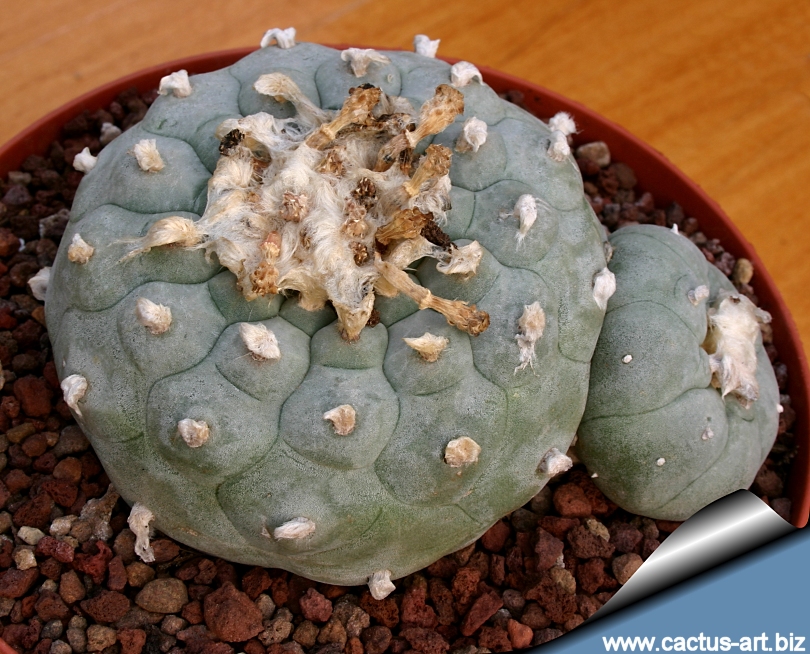
Lophophora williamsii is one of the most and ornamental
cacti.
|
|
Description: Solitary or (rarely) caespitose
spineless cactus, normally unicephalous but becoming polycephalous with
age or injury,
Stem: Glaucous green, dull bluish or greyish green, very
succulent, globular, top-shaped, or somewhat flattened up to 6 cm tall,
12 cm diameter, with a woolly top; The subterranean portion of the stem,
which is as wide as the aerial portion, extends several cm below the
surface of the ground and transitions smoothly (through a thin hypocotyl)
into a large taproot which may extend over 25 cm below ground level.
Ribs: (5 when young) 7 to 13 (very rarely 4 or 14 ) broad,
rounded, straight, or spiralled, often tuberculate, sometimes irregular
and indistinct, with transverse furrows forming more or less regular,
polyhedral tubercles;
Roots: Napiform, usually 8-11 cm long
Areoles: Round spineless, bearing flowers only when young with
some bunches of long erect, matted, wooly greyish hairs, up to 1 cm
long.
Flowers: Solitary, campanulate, 1.5-2.5 cm across when open
usually pink (rarely whitish) outer perianth segments and scales
ventrally greenish. They emerge from the mass of hairs at umbilicate
centre of crown each surrounded by a mass of long hairs. Stigma-lobes
5-7, linear, pink.
Blooming season: Flowers sporadically throughout summer.
Fruit: Club-shaped, red to pinkish, 2 cm long or shorter which
can be very delectable and sweet-tasting when eaten.
Seeds: Small and black up to1 mm in diameter, with broad basal
hilum, tuberculate-roughened.
|
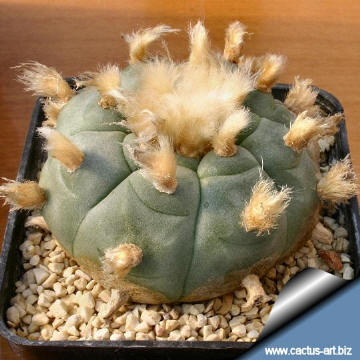 |
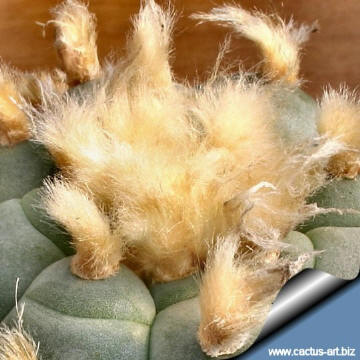
|
|
Often in cultivation forms
beautiful long tuft of wool from the areoles.
|
|
Cultivation:
All Lophophora species are extremely slow growing, often taking
up to thirty years to reach flowering age in the wild (about the size of
a golf ball, not including its root). Human cultivated specimens grow
considerably faster, usually taking from six to ten years to go from
seedling to mature flowering adult.
Because of the tap root
they are very rot prone, so use highly gritty compost with much drainage.
Requires half shade to part sun. Waterings should be
rather infrequent to keep the plant compact and not to become
excessively elongated and unnatural in appearance,
watering it properly is often difficult
because this plant tends to crack open or rot if over-watered.
The fact that the plant retracts into the soil and assume a grey-green
colouring between watering, is perfectly natural and doesn’t cause any
damage.
Overwatering: Keep completely dry and cool in winter (An unheated
greenhouse would be perfect) or when night temperatures remain below 10°
C, it can survive low temperatures (appr. -7°C) for a short
period. Assure a good ventilation.
Propagation: Easy to
propagate from seeds. The seeds are, requiring hot and humid
conditions to germinate.
|
|
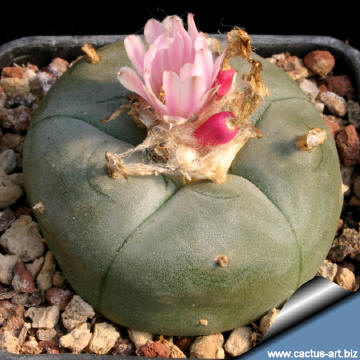 |
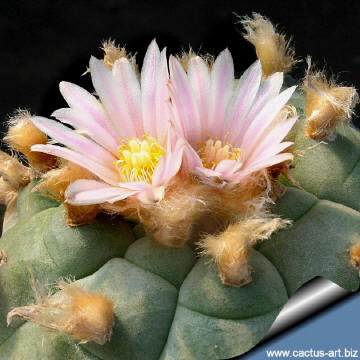
|
|
USES: Peyote has been used for centuries for the mystical effects
experienced when it is ingested. It contains a large spectrum of
phenethylamine alkaloids, the principal of which is mescaline. The top
of the cactus that grows above ground, also referred to as the crown,
consists of disc-shaped buttons that are cut from the roots and dried.
These buttons are generally chewed, or boiled in water to produce a
psychoactive tea. The resulting infusion is extremely bitter and, in
most cases, the user experiences a high degree of nausea before the
onset of the psychedelic effects.
However cultivated plants have only traces of the alkaloid present in wild
harvested plant and their “psychedelic” effect are minimal or completely
absent, but they still cause nausea, vomit, headache. |
|
Photo of conspecific taxa, varieties, forms and
cultivars of
plants belonging to the
Lophophora williamsii complex
(This
Taxon
has several controversial varieties and subspecies and comprises a multitude of different forms, but where each form
is linked to others by populations of plants with intermediate
characteristics):
|
|


Advertising
|
|
|
|
|
Family:
Cactaceae (Cactus
Family) |
|
Scientific name:
Lophophora williamsii
(Lem. ex ex Salm-Dyck.) Coulter
in Contrib. U.S. Nat. Herb. 3 (1894) 131.
Origin:
Grows in an area that stretches from from the Chihuahuan Desert
to the South Texas Plains, on either side of the middle and lower Rio
Grande River, southward to the Mexican state of San Luís Potosí.
Extensive stands of peyote occur on the low, rocky hills in Starr,
Zapata, Webb, and Jim Hogg counties of southern Texas.
Habitat: Grows isolated or in groups usually in
calcareous deserts, on rocky slopes, or in dried river beds.
Conservation status: Listed in
CITES appendix 2.
Common Names include: Peyote, mescal buttons, muscal buttons,
pellote.
|
Synonyms:
- Anhalonium
williamsii Eng., 1854
-
Echinocactus rapa Fischer et Meyer,
1869
- Ariocarpus
williamsii (Lem.) Voss., 1872
- Anhalonium
williamsii (Lem.) Rümpler, 1886
- Lophophora lewinii
Rusby, 1894
-
Lophophora williamsii lewinii (Henn.)
Coulter, 1894
- Echinocactus
lewinii Hennings, 1895
- Mammillaria lewinii
Karsten, 1895
- Lophophora lewinii
Thompson, 1898
-
Echinocactus williamsii "Hylaeid α"
pelotinica Sch. K., 1898
-
Echinocactus williamsii "Hylaeid β" v.
anhalonica K. Schumann, 1898
-
Echinocactus williamsii var. pelotinica
Rouh., 1927
-
Echinocactus williamsii var. anhalonica
Rouh., 1927
- Lophophora
caespitosa Krzgr., 1935
- Lophophora texana
Fric ex Roeder, 1935
- Lophophora
williamsii var. decipiens Croizat, 1944
- Lophophora
williamsii var. pentagona Croizat, 1944
- Lophophora
williamsii var. pluricostata Croizat, 1944
- Lophophora echinata
Croizat, 1944
-
Lophophora williamsii var. texana
Krzgr., 1961
- Lophophora lutea
var. texana (Fric ex Krzgr.) Backbg., 1961
- Lophophora willi

A Lophophora williamsii and an Ariocarpus kotsckoubeyanus in ther
natural
habitat in Mina, Nuevo Leon, among dried mud.
(Photo by: Marco Antonio Arroyo, Mexico)
|
|
|
|
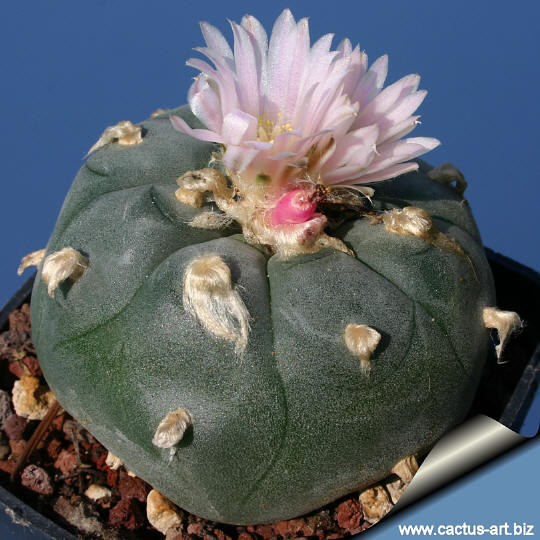
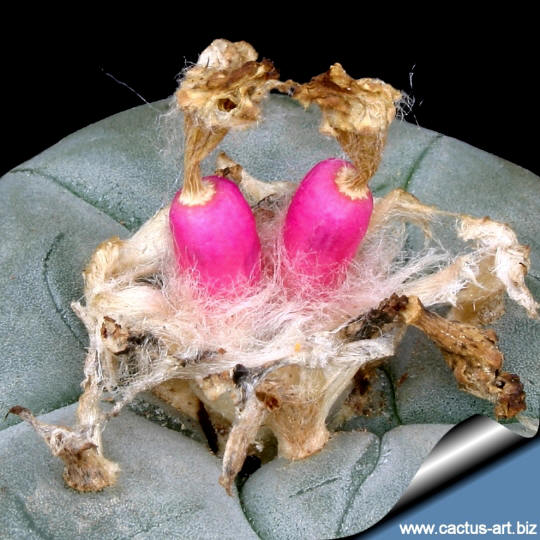
|
|